Your cart is currently empty!
Understanding Period Costs and Affordable Alternatives

Have you ever stopped to consider how much money you spend on menstruation products throughout your lifetime? For the average woman, menstruation begins around age 9–12 and continues until 45–50. That’s 35–38 years of menstruation, averaging about 12 periods per year. In total, most women experience around 456 periods in their reproductive lifetime, contributing significantly to what we call period costs. This adds up to a significant financial commitment, often referred to as period costs.
What Is a Period Cost?
In financial terms, a period cost is an expense that is not directly tied to production but is necessary for daily life. In the context of women’s health, period costs refer to the ongoing expenses of purchasing menstrual products such as pads, tampons, or liners. Unlike a product cost vs. period cost in accounting, where the difference relates to manufacturing vs. non-manufacturing expenses, here it highlights the recurring nature of menstruation expenses compared to one-time purchases like a menstrual cup. Period costs significantly impact a woman’s budget over time.
Examples of Period Costs
To better understand the scale, let’s break it down:
- On an average menstrual day, a woman uses 3–7 pads or tampons.
- Over a 5-day period, this equals 15–35 pads or tampons per cycle. These contribute to the common period costs we encounter.
- Multiply that by 456 periods over a lifetime, and the total use comes to 6,840–15,960 products.
Now, consider the price of your preferred brand. Multiply the cost of one pack by the number of products you use monthly, and then by 456 cycles—it quickly becomes clear that period costs add up to thousands of dollars over a woman’s lifetime.
A Cost-Effective Alternative: The Leia Menstrual Cup
Instead of spending money on disposable products every month, the Leia menstrual cup offers a sustainable and affordable option. Unlike pads and tampons, which must be repurchased monthly, one cup can last up to 15 years. This offers a dramatic reduction in total period costs over time.
By switching to a menstrual cup, you could redirect the money usually spent on period-related costs toward more meaningful things—education, hobbies, travel, or savings.
Sustainability and Environmental Benefits
Beyond financial savings, menstrual cups have a significant environmental advantage. Disposable pads and tampons generate large amounts of waste that end up in landfills. A reusable cup, however, drastically reduces waste and supports a more eco-conscious lifestyle, thus lowering the overall period costs to the environment.
Additionally, menstrual cups are convenient and comfortable:
- Can be worn up to 12 hours
- Safe, medical-grade silicone
- No need to carry multiple products or worry about leaks
Product vs. Period Cost: Why the Difference Matters
When comparing product vs. period cost, the financial difference is clear. Disposable menstrual products are recurring period costs, adding up over time. A menstrual cup, however, is a product cost—a one-time purchase with long-term savings and benefits.
The financial and environmental impact of menstruation is often overlooked. However, understanding what a period cost is and seeing real examples of period expenses reveals just how much money women spend throughout their lives. The Leia menstrual cup provides a transformative, cost-effective, and eco-friendly solution.
By making the switch, you not only save thousands of dollars but also take an active step toward sustainability. It’s a small change with a huge impact—on your wallet, your comfort, and the planet, all while decreasing your overall period costs.
Archive
Recent Posts
- Decoding Medical Silicone: From Breast Implants to Leia Menstrual Cups
- Understanding the Importance of Pelvic Floor Health
- Decoding Irregular Periods: Understanding Causes and Effective Management
- Navigating Intimacy: A Gynecologist’s Perspective on Sex During Menstruation
- Revitalize Your Pelvic Floor in 5 Minutes: Quick Exercises for Intimate Muscle Health
Tags
ActivePeriods AdventureFriendly Awarness Best menstrual cups Break Taboos CervixHealth ComfortableChoices Cups for teens Eco-Initiatives Empowered youth Empowerment Endometriosis Care Environmentally Environmentally Friendly ExerciseEnthusiasts FreeBleeding Friendly Leia Menstrual Cups FSA Green Choices GynecologistOpinion HassleFreePeriods HealthAndHygiene HealthAwareness HSA HSAvsFSA Hypoallergenic Care Leia Menstrual Cups leiathecup LowCervixComfort Low cervix menstrual cup usage Medical Expenses menstrualcupHSA Menstrual cups low cervix Menstrual Health Education pelvic floor muscles Period Care Personalized Peroid Care Supportive Community Sustainability Sustainable Impact TravelWithCups VaginalHealth WomenHealth WomensHealth WomenWellness
